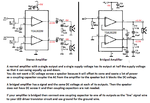gonadgranny
Member level 4

Hi all. I am currently working on a project which involves an mp3 module and i would like to get an led to react (in light intensity level) to the amplitude of the signal it generates. i am using a transistor to drive the led with the base connected to one of the mp3 modules speaker outputs which is amplified(enough to power a 5w speaker).the emitter is connected to a 5v source. i am aware that the led will only allow current through it in one direction so i am effectively only getting half of the waveform but it seems to work anyway. the problem i am having is that even when there is no sound playing the output generates about 2.5v so there is a constant glow on the led which makes the effect less impressive.
can anyone give advice on how to stop this? some way of getting the transistor to only react to voltages above a certain threshold for example?
ive tried connecting the transistor to the un-amplified source but it doesnt work as the voltage must be too low.
the transistor which i am using is the pn222a.
any help would be much appreciated.
thanks,
Dan.
can anyone give advice on how to stop this? some way of getting the transistor to only react to voltages above a certain threshold for example?
ive tried connecting the transistor to the un-amplified source but it doesnt work as the voltage must be too low.
the transistor which i am using is the pn222a.
any help would be much appreciated.
thanks,
Dan.


